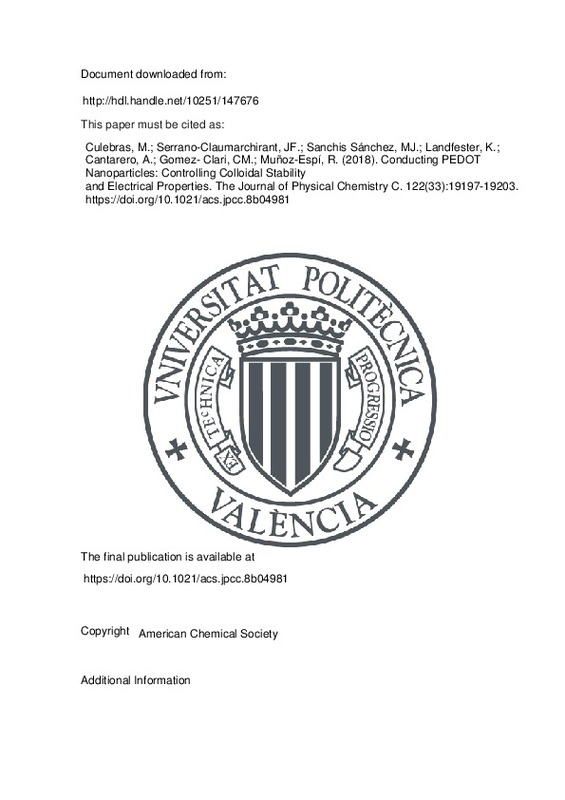JavaScript is disabled for your browser. Some features of this site may not work without it.
Buscar en RiuNet
Listar
Mi cuenta
Estadísticas
Ayuda RiuNet
Admin. UPV
Conducting PEDOT Nanoparticles: Controlling Colloidal Stability and Electrical Properties
Mostrar el registro sencillo del ítem
Ficheros en el ítem
| dc.contributor.author | Culebras,M.
|
es_ES |
| dc.contributor.author | Serrano-Claumarchirant, José F.
|
es_ES |
| dc.contributor.author | Sanchis Sánchez, María Jesús
|
es_ES |
| dc.contributor.author | Landfester, Katharina
|
es_ES |
| dc.contributor.author | Cantarero, A.
|
es_ES |
| dc.contributor.author | Gomez- Clari, Clara Maria
|
es_ES |
| dc.contributor.author | Muñoz-Espí, Rafael
|
es_ES |
| dc.date.accessioned | 2020-07-09T03:31:45Z | |
| dc.date.available | 2020-07-09T03:31:45Z | |
| dc.date.issued | 2018-08-23 | es_ES |
| dc.identifier.issn | 1932-7447 | es_ES |
| dc.identifier.uri | http://hdl.handle.net/10251/147676 | |
| dc.description.abstract | [EN] The synthesis of conducting polymer nano particles by oxidative polymerization can be a challenge because the addition of oxidizers may compromise the colloidal stability of the system. In this work, we report the successful synthesis of poly(3,4-ethylenedioxythiophene) (PEDOT) nanoparticles by means of miniemulsion polymerization. We study the role of oxidizing agents (iron(III) p-toluenesulfonate and hydrogen peroxide) during the particle formation and in the electric properties. The presence of hydrogen peroxide is demonstrated to be crucial in the macroscopic stability of the suspensions and in the morphology of the resulting nanoparticles. The obtained suspensions, containing particles of diameters of around 30 nm, are stable for several months. The electrical conductivity increases with increasing the content of iron(III) p-toluenesulfonate, but it decreases with addition of hydrogen peroxide, which can be explained by secondary reactions in the polymerization process. | es_ES |
| dc.description.sponsorship | The authors acknowledge the financial support from the Direction General de Investigation Cientifica y Tecnica through a grant of the Program Consolider Ingenio (Grant CSD2010-0044) and Grant MAT2015-63955-R. The authors also thank the Max Planck Society through the funding of the Max Planck Partner Group on Colloidal Methods for Multifunctional Materials (CM3) at the University of Valencia, headed by R.M.E. M.C. acknowledges the financial support by the Spanish Ministry of Education, Culture and Sport through the FPU training program and the German Academic Exchange Service (DAAD) for a short-term research scholarship at the Max Planck Institute for Polymer Research. Finally, R.M.E. thanks the financial support from the Spanish Ministry of Economy and Competitiveness through a Ramon y Cajal grant (Grant RYC-2013-13451). | es_ES |
| dc.language | Inglés | es_ES |
| dc.publisher | American Chemical Society | es_ES |
| dc.relation.ispartof | The Journal of Physical Chemistry C | es_ES |
| dc.rights | Reserva de todos los derechos | es_ES |
| dc.subject.classification | MAQUINAS Y MOTORES TERMICOS | es_ES |
| dc.title | Conducting PEDOT Nanoparticles: Controlling Colloidal Stability and Electrical Properties | es_ES |
| dc.type | Artículo | es_ES |
| dc.identifier.doi | 10.1021/acs.jpcc.8b04981 | es_ES |
| dc.relation.projectID | info:eu-repo/grantAgreement/MICINN//CSD2010-00044/ES/TAILORING ELECTRONIC AND PHONONIC PROPERTIES OF NANOMATERIALS: TOWARDS IMPROVED THERMOELECTRICITY (NANO THERM)/ | es_ES |
| dc.relation.projectID | info:eu-repo/grantAgreement/MINECO//RYC-2013-13451/ES/RYC-2013-13451/ | es_ES |
| dc.relation.projectID | info:eu-repo/grantAgreement/MINECO//MAT2015-63955-R/ES/NANOESTRUCTURAS SEMICONDUCTORAS Y NANOCOMPOSITES PARA LA RECUPERACION ENERGETICA/ | es_ES |
| dc.rights.accessRights | Abierto | es_ES |
| dc.contributor.affiliation | Universitat Politècnica de València. Departamento de Termodinámica Aplicada - Departament de Termodinàmica Aplicada | es_ES |
| dc.description.bibliographicCitation | Culebras, M.; Serrano-Claumarchirant, JF.; Sanchis Sánchez, MJ.; Landfester, K.; Cantarero, A.; Gomez- Clari, CM.; Muñoz-Espí, R. (2018). Conducting PEDOT Nanoparticles: Controlling Colloidal Stability and Electrical Properties. The Journal of Physical Chemistry C. 122(33):19197-19203. https://doi.org/10.1021/acs.jpcc.8b04981 | es_ES |
| dc.description.accrualMethod | S | es_ES |
| dc.relation.publisherversion | https://doi.org/10.1021/acs.jpcc.8b04981 | es_ES |
| dc.description.upvformatpinicio | 19197 | es_ES |
| dc.description.upvformatpfin | 19203 | es_ES |
| dc.type.version | info:eu-repo/semantics/publishedVersion | es_ES |
| dc.description.volume | 122 | es_ES |
| dc.description.issue | 33 | es_ES |
| dc.relation.pasarela | S\378783 | es_ES |
| dc.contributor.funder | Max Planck Society | es_ES |
| dc.contributor.funder | Ministerio de Economía y Competitividad | es_ES |
| dc.contributor.funder | Ministerio de Educación, Cultura y Deporte | es_ES |
| dc.contributor.funder | Ministerio de Ciencia e Innovación | es_ES |







![[Cerrado]](/themes/UPV/images/candado.png)

